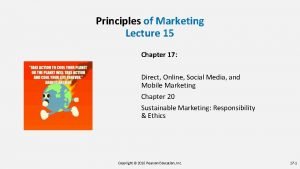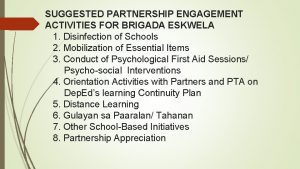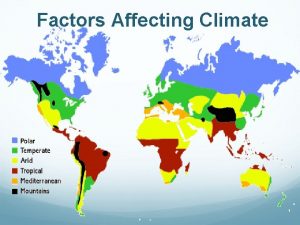Creating Engaging Activities Factors Affecting Engagement Factors Affecting










- Slides: 10

Creating Engaging Activities Factors Affecting Engagement

Factors Affecting Engagement Learners Knowledge Interest Level Time Constraints Learning Styles Mode of Instruction Location / Space

Check Yourself. Taking into consideration such factors such as who the learner identity, learning style, mode of instruction, physical location, and time constraints may determine unforeseen bias, gaps in instructors that could ultimately, create a better activity. Learners Knowledge Interest Level Time Constraints Learning Styles Mode of Instruction Location / Space Even if you just consider one factor for one minute.

Who is your learner? Learners Knowledge Learning Styles Mode of Instruction Who is the learner? What are your perceptions of the learner(s)? How does your perception affect how you might create an activity? If there are multiple learner roles within your activity what might change how you create it Interest Level Time Constraints Location / Space Self Student Participant Colleague Supervisor Administrator Other Unknown

Consider Learning Styles Even if you do not know the learning styles of your participants, consider how much you rely on a particular form of learning when you create activities. For example, if you do a lot of group work what impact does an individual who processes internally with having to speak frequently “off the cuff. ” Learner Knowledge Learning Styles Mode of Instruction Interest Level Time Constraints Location / Space Intrapersonal Interpersonal Spatial / Visual Bodily /Kinesthetic Logical Verbal Musical

Mode of Instruction You may have no control over the mode of instruction. Being aware of that mode’s strengths and weaknesses will help to determine if and how to proceed with a desired activity. For example, if you are looking to utilize group work in an online environment, you will need to carefully construct not only activity instructions but consider where to put “reinforcements” if you want it to be successful. Learner Knowledge Learning Styles Mode of Instruction Interest Level Time Constraints Location / Space In-Person / F 2 F Supplemental / Enhanced Blended Fully Online (Facilitated) Full Online (Self-Paced) MOOC (Facilitated)

Location / Space Learner Knowledge Learning Styles Mode of Instruction Interest Level Does your location affect how you conduct the activity? What are the barriers for participants to complete the activity whether working with one another or by themselves? Is the location crucial and can be changed? Would the acting of changing the location and space benefit the participants? If you can’t change, how can you accommodate? Time Constraints Location / Space Traditional Classroom Public (Reoccurring) Public (One-Time) Office (Work) Office (Home) Hospital Computer Lab Forest

Time Constraints Learner Knowledge Learning Styles Mode of Instruction Interest Level How does time play a factor? Do you have a limited or significant amount of time to conduct the activity? If you have a a reoccurring activity, are you budgeting enough time to for each week to accomplish this task? Does this activity shadow other activities? What can be cut for time but still meet your activity objectives? Time Constraints Location / Space Semester Length One Session / Unit Multiple Sessions / Units Months Years Workshop ( <Day ) Workshop ( >Day)

Interest Level Learner Knowledge Learning Styles Mode of Instruction Interest Level How are interested are participants going to be? Is this required or mandatory? Is it seen as punishment or punitive for some unknown / unknown action? Did they willingly sign up for this session / class? Are these professionals in a field or highly motivated individuals? How much will this activity or class affect them for the better? Although difficult to determine interest, considering it may be helpful when developing an activity. Time Constraints Location / Space Excited Invested Motivated Indifferent Apathetic Disinterested Unknown

Knowledge Learner Knowledge Learning Styles Mode of Instruction Interest Level Taking into consideration the level of knowledge participants can help in many ways. Individuals that have a high level skill-set can start from a more advanced point of conversation. Rather than focusing on fundamentals, participants can delve into more practice or outcomes based activities. Experts can also share creating the activity. Individuals unfamiliar with subject matter may need more theoretical components or concrete activities. Meeting at participants knowledge level may provide ownership over learning to some while not losing others unfamiliar with topics / content. Time Constraints Location / Space Expert Novice
 Creating customer relationships and value through marketing
Creating customer relationships and value through marketing Marketing involve engaging directly with carefully targeted
Marketing involve engaging directly with carefully targeted Marketing involve engaging directly with carefully targeted
Marketing involve engaging directly with carefully targeted Occipito posterior position
Occipito posterior position Dynamisch verbinden
Dynamisch verbinden Sample activities in brigada eskwela
Sample activities in brigada eskwela Engagement activities for virtual meetings
Engagement activities for virtual meetings Definition of primary activities
Definition of primary activities The statement of cash flows helps users
The statement of cash flows helps users How do you find these activities
How do you find these activities Support activities and primary activities
Support activities and primary activities



















